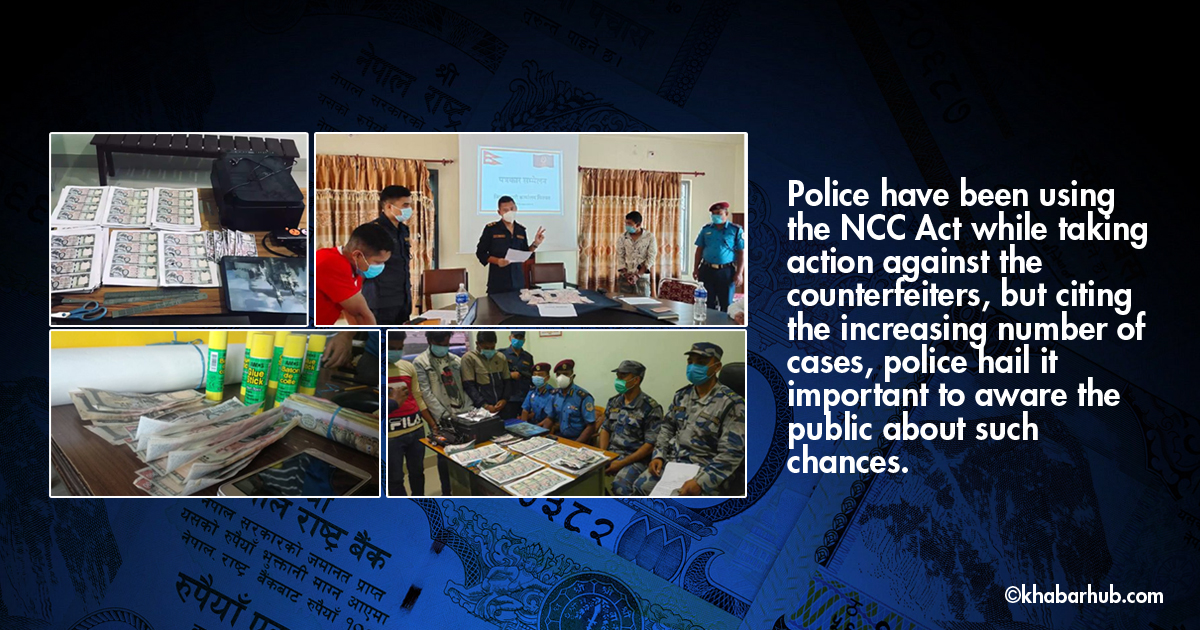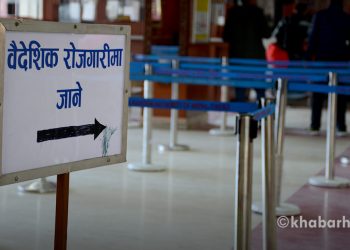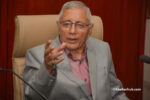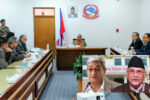KATHMANDU: Nepal Police nabbed gangs indulged in the transactions of counterfeit currency from two different places on the eve of major festivals Dashain and Tihar.
Three people who were printing fake currency were nabbed with 384 thousand such currencies from Golbazaar-6, Siraha on November 12, one day before Tihar started.
Similarly, a man was arrested with 302 thousand fake currencies from Raksirang, Makawanpur on October 23, the seventh day of Dashain.
Those arrested in Golbazaar are Bimalendra Kumar Nayak, 24 of Kalyanpur-7, and Dhiraj Yadav 25 and Sanjaya Raya 20 of Golbazaar 12.
DSP Shaligram Sharma Paudel, the information officer at the District Police Office Siraha told Khabarhub that they were arrested following the clue the police had received about the fake currency transaction.
The police seized three sets of mobile phones, one laptop, one color printer and a knife from them.
According to DSP Paudel, Rs 300 thousand were ready to be dispatched to market whereas another 384 thousand rupees were printed in photocopy paper waited to be shredded into different bundles when raided.
According to Chitwan District Police Chief, SP Nanti Raj Gurung, the fake currency was seized from Jit Bahadur Lopchan’s house at Makawanpur-8, Halije.
The team of police, including those from Area Police Office Mirchaiya and the Armed Police Force, has jointly raided the area.
Similarly, the police nabbed 302 thousand fake currencies hidden in the corn pile in Raksirang, Makawanpur on October 23.
According to Chitwan District Police Chief, SP Nanti Raj Gurung, the fake currency was seized from Jit Bahadur Lopchan’s house at Makawanpur-8, Halije.
“Halije is an area notorious for marijuana farming, we are investigating to see if the fake currency was used by the traffickers,” he said.
These two incidents show the fake currency network has expanded beyond the capital valley now.
SSP Kuber Kadayat tells that especially in Birgunj, Dhangadhi and other urban areas bordering India have been used as a haven for the circulation of the fake currency of late.
The police investigation shows that the racketeers tempt and involve the ambitious youths for the execution of such crimes. The racketeers have been executing organized crime.
Fake Nepali currency seized from Kathmandu in last three years
July 31, 2020: A Nepali national arrested from Shantinagar, Kathmandu with 10 fake notes of Rs 1,000
July 24, 2020: A Nepali national arrested from Budhanilkantha, Kathmandu with 19 fake notes of Rs 1,000
January 9, 2020: Four arrested from a fake currency printing center in Kathmandu, fake currency worth 413 thousand seized
October 21, 2019: Three arrested from Gokarneshwor-6, Nayabasti; 34 fake notes of Rs 1,000 and the device used to print the notes seized from them
January 30, 2019: One arrested from Gongabu, Kathmandu with fake Nepali currency worth Rs 150 thousand
October 21, 2018: Five arrested from different places in the capital with fake Nepali currency worth Rs 370 thousand
October 12, 2018: One arrested from Ratna Park, Kathmandu with fake currency worth Rs 10000
October 9, 2018: One arrested from Ratna Park, Kathmandu with fake currency worth Rs 5,000
May 16, 2018: Six arrested with fake currency worth Rs 26.06 million
(Source: Metropolitan Police Circle, Kathmandu)
Besides, there have been several cases of fake Nepali currency in Kathmandu. According to SSP Gyawali, lately, Kathmandu has witnessed several instances of fake currency quite frequently.
“Previously, there used to be the cases of fake Indian currency, but nowadays, instances of Nepali fake currency are quite frequent,” he conceded.
The watermark is not a print on the paper, it’s there while making the paper itself, so it is distinct and can be seen from both sides, but the fake currencies don’t have such a feature.
According to him, the criminals have been using color photocopy machine to print Nepali notes. Currently, Nepal Police have seized the printing devices from many places in Kathmandu.
Police record shows that the instances of fake currency are more common especially during the festival time at the cramped places with high transaction frequency.
“Restaurants, shops and places with more transaction ratios are regarded as a safe haven for the criminals,” police sources claim.
Involvement of organized criminal groups in fake currency transactions
Experts point out that organized groups are particularly involved in making and circulating fake currencies in Nepal.
“The ambitious youths, particularly, work in an organized way to execute the transaction of fake currency,” former DIG Devendra Subedi, who has spent considerable time in the Crime Investigation Bureau of Nepal Police said.
“There are some Indians as well,” he said adding that the main market of fake Nepali currency is Nepal itself.
The counterfeiters chose crowded areas and the places which make big transactions and insert the fake notes in the bundles so as to let the counterfeit money circulate without hindrance.
Former DIG Hemanta Malla who has spent considerable time in top posts of the Central Investigation Bureau and Special Bureau claims that fake currency transactions are getting quite frequent in Nepal now.
“A few years ago, if anyone talked about counterfeit money, obviously it used to be Indian currency. However, the case is getting more complicated these days.” Malla added.
“Most of such cases in Nepal are related to Nepali fake currency. What’s more! Now the printers and factories are also found in Nepal,” he shed light on the current trends.
Malla expects cooperation from the public in curbing the circulation of fake currency.
How to identify counterfeit currency from the genuine one
The officials at Nepal Rastra Bank suggest people look at watermark to distinguish the fake note from the genuine one.
“When we turn the note towards the light and look on it we can see the image of rhododendron on it,” NRB officials say, “the watermark is distinct whale looking at the note from both sides.”
The watermark is not a print on the paper, it’s there while making the paper itself, so it is distinct and can be seen from both sides, but the fake currencies don’t have such a feature.
Another method of distinguishing the fake currency is looking for the security thread. In it, one can see NRB and the mirror image of NRB in order.
Like the rhododendron watermark, the security thread is also inserted while making the paper itself.
The printed words or marks in the notes can be seen even at the place where the security thread is inserted.
What do legal provisions say?
Clause 256 of the National Criminal Code Act 2017 has provisions related to counterfeit money. This clause provisions that a person involved in such crime can be fined from Rs 50 thousand to Rs 100 thousand along with 5-10 years imprisonment.
Police have been using the NCC Act while taking action against the counterfeiters, but citing the increasing number of cases, former AIG Subedi hails it important to aware the public about such chances.









Comment